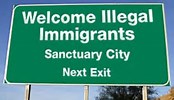INTRODUCTION by Rodney Atkinson. In the pursuit of supranational corporate power (‘globalism”) over democratic nations and parliaments the corporatist right and the fascist left, have found ways to break, override or bypass national laws. Sanctuary Cities, most prominently in the USA, are the most potent form of this attack. Local and regional authorities are simply ignoring the national law and national parliaments and pursuing their own private global, social and economic policies.
Big business exploits illegal immigrants to increase profits through cheap labour, the elitist Left do so to eliminate “bourgeois” democracy, national identity and racial cultures.
The cliques of business interest groups, originally restricted to supranational manipulation of democracies through for example the European Union, now extend to multi cultural, migration promoting, supranational socialist and LGBT lobbies operating through the EU and the UN – because the declarations of their activists cannot be easily challenged by democratic voters organised within nation states. The democratic nations are then intimidated into accepting those “laws”.
Sanctuary Cities of course are not even as legal as that – they positively break the law, encourage mass illegal migrations, condone criminal migrants and resist punishment for crimes by illegals which would lead to prison for legal migrants and ordinary citizens.
The Fascist left or right exploit waves of capital and people, social upheavals and war conditions to wash away the borders of free nations, their rule of law, their parliaments and their voters to establish their global hegemonies. Sanctuary cities are now one of their favourite weapons against democratic nations.
SONYA JAY PORTER:
For hundreds of years Sanctuary could be claimed in Britain by fugitives from the law as soon as they entered a Church, for once inside they could not be arrested by either police or army. Now, in the USA and elsewhere there are Sanctuary Cities which provide the same safety for immigrants who have entered the country illegally. Once inside, the law of the land seems not to run, nor do the police seem able to arrest them – or even want to.
Many immigrants into the USA are there, of course, quite legally or are awaiting permanent resident status, but over recent years, large numbers have managed to avoid all border controls and the possibility of deportation, and because of this in 1996 the American Congress passed an Illegal Immigration Responsibility Act to control the flood. It required local governments to co-operate with the Department of Homeland on the matter but nevertheless, hundreds of communities have ignored the law and adopted so-called “sanctuary policies”. These are both formal, written policies and informal unwritten ones but both gave great lee-way to illegal immigrants. Depending on where they have settled, illegal aliens are able to live, find work, obtain drivers licences and even various benefits. (Note that much such documentation is used for voter fraud – RA). Police can be prevented from inquiring about anyone’s legal status unless they are stopped or arrested for a serious crime and State employees may be unable to even report the presence of illegal aliens.
One justification for creating sanctuary cities is often under the guise of protecting ‘immigrant rights’ but illegal aliens are not legal immigrants. Another false argument public officials use to justify these sanctuary policies is ‘public safety’. But if they were not there, these illegal aliens would neither be victims of crime nor could they victimise legal US citizens.
So, why do public officials pass sanctuary laws or establish unwritten “don’t ask–don’t tell” policies? In some cases it may simply be financial: political contributions and ethnic voter support. Or that public officials wish to avoid the political protests and expensive lawsuits that routinely follow any attempt by cities who try to stop illegal aliens from settling in their communities. Or that they just don’t care and supporting sanctuary policies are simply the path of least resistance for city officials. Some politicians may just attempt to appease politically powerful illegal immigration support groups in order to keep their jobs. It may well be that an Administration shares a similar political ideology to the incoming migrants. Or simply that being the descendants of immigrants themselves, the local people feel an obligation not to prevent others from enjoying the same ‘better life’ that their families obtained through immigration into the USA.
In 1979, the City of Los Angeles became the first municipal government to adopt Sanctuary City policies and since then a further 38 cities, 364 counties and four states have put some form of sanctuary policy in place assisting, the Immigrant Legal Resource Center has estimated, some 11 million illegal aliens.
And these policies are all paid for by the US tax payers and by legal immigrants.
During his campaign in 2016 to be President, Donald Trump criticized cities with sanctuary policies, often discussing the death of a 32-year-old San Franciscan woman who was murdered in July 2015, the suspect being a Mexican national who had been deported five times before the shooting. Trump was determined, he said, to cut federal funds to Sanctuary Cities which routinely refused to hold undocumented migrants in local jails until immigration officials were able to take them into custody.
But from the day after he was elected, President Donald Trump has faced country-wide opposition to these plans. On 25th January, 2017, shortly after his inauguration, he passed an Executive Order to cut off federal funding to Sanctuary Cities which fail to comply with federal immigration demands. This was immediately followed by the blocking of this Order by a judge in San Francisco who said that not only would the City lose some $1 billion in funds, but that the language of the Order made it clear the Trump Administration planned to use it to block funding for more than just law enforcement as federal lawyers had argued.
On 21st April, the Trump Administration threatened to withhold grant money from Sanctuary Cities that refused to comply with the Order which was followed on the same day by San Francisco filing a challenge that his Executive Order was ‘not only unconstitutional but unAmerican’. But on 28th April, the House of Representatives of Texas voted for a measure that would ban Sanctuary Cities which refuse to co-operate with the Federal Immigration Authorities in the State and on 8th May the Texas Governor signed a Senate Bill which will ban Sanctuary Cities in the Lone Star State altogether. Again on 8th May, Emory University, a leading research University in Atlanta, Georgia, decided to fund 100 percent of the financial aid packages granted to illegal immigrants, so breaking the law.
Sanctuary Cities, Sanctuary States, Sanctuary Campuses — how much further will the Sanctuary battle go?
A number of Canadian cities, such as Toronto, Vancouver and Montreal, have now declared themselves sanctuaries for undocumented migrants. Here in the UK, Sheffield was declared its first Sanctuary City in 2007 and the term now refers to approximately 80 areas, towns and cities which provide welcome and aid for people seeking sanctuary from war and other forms of persecution. Which is very laudable.
Swansea became the UK’s second official City of Sanctuary in May 2010 but Wales has recently gone further. In April 2017 a group within the National Assembly called for Wales to become the world’s first Nation of Sanctuary, recommending that the Welsh Government improve integration plans for asylum accommodation, education, employment and for establishing a guardianship service for unaccompanied asylum-seeking children.
However, since Wales is a Principality and not a sovereign state and whether the people of Wales would be willing or able to pay for this largesse, make this a very uncertain though charitable project.
And eventually, it will be the tax paying public who will decide both in North America and the UK whether Sanctuary Cities do, in fact, continue to exist.


















